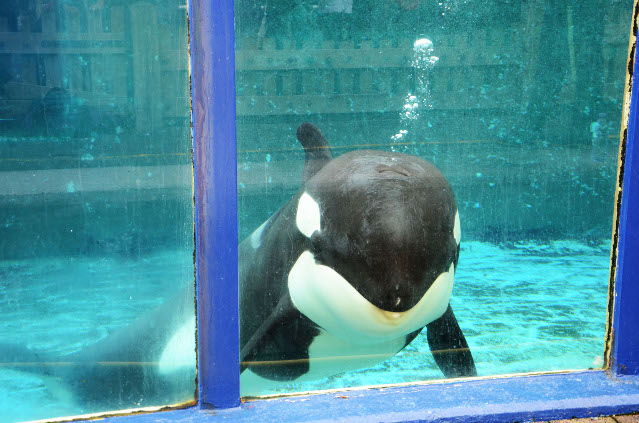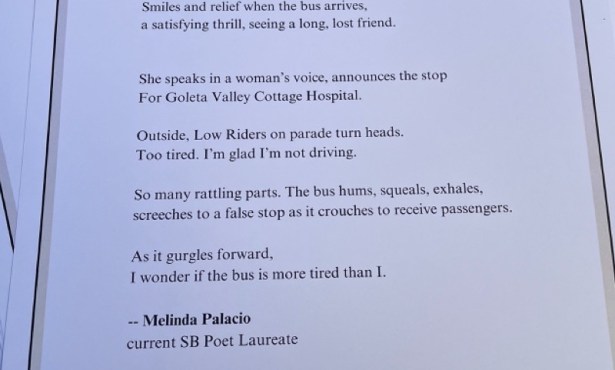Orca Tug-of-War
Activists and Scientists Challenge SeaWorld Over Morgan's Captivity

Today, a judge in the Netherlands will decide the fate of Morgan the orca. For months, orca experts and activists have fought for her release from Dutch marine mammal center Dolfinarium Harderwijk back into the wild. The Dolfinarium, however, is supported by SeaWorld Parks & Entertainment, which would like to move Morgan to Loro Parque, a zoo in Spain.
Morgan was rescued by the Dolfinarium Harderwijk in June of last year after she was found in poor condition in Dutch waters. The killer whale has since been nursed back to health, but the dispute over her future made its way to court because the Dolfinarium does not own Morgan and therefore has no say in what happens to her now. The facility has a permit to rehabilitate her – and would like to keep her there – but the next move is up to the Dutch Government.
A group of Santa Barbara residents – lead by animal activist Dove Joans – support the release of Morgan. When Joans was made aware of Morgan’s plight about a month ago, she arranged to make a PSA to throw a spotlight on the issue. “It was the best and immediate way for me to answer Morgan’s urgent call for help,” Joans said of the strategy. “By bringing attention to Morgan’s life story – and the possibility of her losing her freedom – it’s a way to educate the public that captivity is not the answer to understanding our ‘intellectual counterpart’ in the ocean.”
“The PSA,” Joans went on, “gives the Santa Barbara community and the public worldwide a chance to take a stand, hopefully motivating individuals to make a difference not only in Morgan’s life but also in future generations of humans and cetaceans.”
Shot by Santa Barbara’s Low Tide Rising studio, the PSA features some of the area’s most recognizable ocean lovers. Jean-Michel Cousteau of Ocean Futures Society emphasizes in the recording that this is an “emotional situation” and that a “marine mammal in captivity is like a human in prison.” He encourages people to go whale watching because, as he put it, “It’s so much more interesting than seeing an orca in a tank.” In an interview after the shoot, Cousteau credited the Dolfinarium Harderwijk with doing the right thing “by capturing Morgan to help her get better. Now,” he went on, “the right thing would be to release her, let her go home. If you go to the hospital and get treated, you still go home once you’re healthy.”
Sculptor Bud Bottoms, who created the Santa Barbara Friendship Fountain that marks the entrance to Stearns Wharf, also appears in the PSA because, “Anything that has to do with saving sea mammals, I endorse 100 percent,” he said. Bottoms also referred to the orca named Keiko who became world famous for his role in the movie Free Willy. After his appearance in the film – and 19 years in captivity – letters from millions of children all over the world helped encourage his release. “The children freed Keiko,” said Bottoms. “We should get off our high horse and help Morgan.”
Leading orca researcher Dr. Ingrid Visser of New Zealand, who has dedicated the past few months to Morgan’s release effort and who also appears in the PSA, claims that putting Morgan back into the wild and reuniting her with her family is the only right thing to do. “The harvesting of orcas around Norway has put an incredible stress on that orca population as a whole,” she explained. “A single individual, such as Morgan, has a huge long term impact on a population. If you remove her, then you are effectively removing a young female who would, if returned, provide another gene source for the population through her offspring.”
As of now, there are three possible destinations for Morgan. A judge stated last month that Morgan will either be exported to Loro Parque on the Spanish island of Tenerife, rehabilitated then released into the wild, or remain at Dolfinarium.
SeaWorld is working with the Dolfinarium Harderwijk to ensure what they believe is the best option for Morgan. Fred Jacobs, SeaWorld spokesperson, told The Independent that “a panel of zoologists and marine scientists issued a report saying that the most humane option for Morgan is to join other members of her species in a zoological setting.”
“One of our former veterinarians, Jim McBain, was on the scientific panel that recommended against any attempt to return Morgan to the wild,” continued Jacobs. “We are working with Dolfinarium Harderwijk and Loro Parque on the transfer of Morgan to [Loro Parque]. We’d like to see her join other members of her species in a high quality, professionally operated zoological institution. Loro Parque is among the world’s most respected zoological institutions.”
Visser, on the other hand, pointed out in an email that, “For Morgan herself, there is no comparison: Live life in a barren concrete tank, be subjected to demeaning and meaningless tricks every day, do no exercise, eat dead fish only, and live for maybe 10 to 20 ‘years.’ Or, return to the ocean where she would have a dynamic habitat with changes such as water temperature and salinity, waves, storms, and getting to travel kilometers in a single day, to feed on a variety of different prey, socialize and play, and live to be around 80 to 90 years old.”
According to Visser, the Dolfinarium made recordings of Morgan’s sonar call to help locate her family somewhere around Norway. However, Jacobs from SeaWorld said, “These individuals do not have any idea who Morgan’s family is or where they are. They don’t have a plausible plan to learn those things.”
“In the meantime,” Jacobs said, “Morgan continues to grow and develop in the care of humans, which means that she has already lost the instinctive fear and suspicion of people that might allow her to succeed in the wild. She has also never acquired any of the communication or group hunting skills that she would need to thrive.”
But, Visser said, it is not too late for Morgan to learn these basic survival methods.
“The Free Morgan Foundation has formulated a very robust plan based on recommendations by CITES (Convention on International Trade in Endangered Species) and IUCN (International Union for Conservation of Nature), and with contributions from the scientific community who have experience with this type of reintroduction. It is multi-faceted with constituency plans and risk assessments. We know it can work because it has in the past,” stated Visser, who continued:
“Morgan has become attached to the humans who hold her captive because they provide her with food. But part of our rehabilitation process is to extinguish that link of food to humans. The Dolfinarium has been encouraging these types of behaviors as ‘excuses’ to keep Morgan in captivity. In the same way she learned them, they can be unlearned.”
Jacobs with SeaWorld said if Morgan does go to Loro Parque, “She will do what the other killer whales there do: interact with other whales and the zoological staff. She may breed some day and have a calf of her own. She, like all whales in our collection, will be the subject of scientific research. And, perhaps most importantly, by her presence alone, she will inspire and educate Loro Parque’s guests.”
Interaction with the zoological staff is, according to Visser “not natural,” and she believes that the only interest SeaWorld has in Morgan is for breeding. “Originally, the Dolfinarium stated that Morgan was only one year old when captured,” she said. “We insisted that she was much older – double that age if nor older. The Dolfinarium used this ‘very young age’ as one of the arguments for her to not be released. Once it was ‘decided’ – by them, we might add – that Morgan couldn’t be released, then suddenly the Dolfinarium started saying that she is four to five years of age. Now that they are stating she is ‘unreleasable,’ she can be entered into their breeding program.”
Whether Morgan will be released and reunited with her family, or if she will make the trip from the Netherlands to Spain, will likely be decided at today’s hearing.



